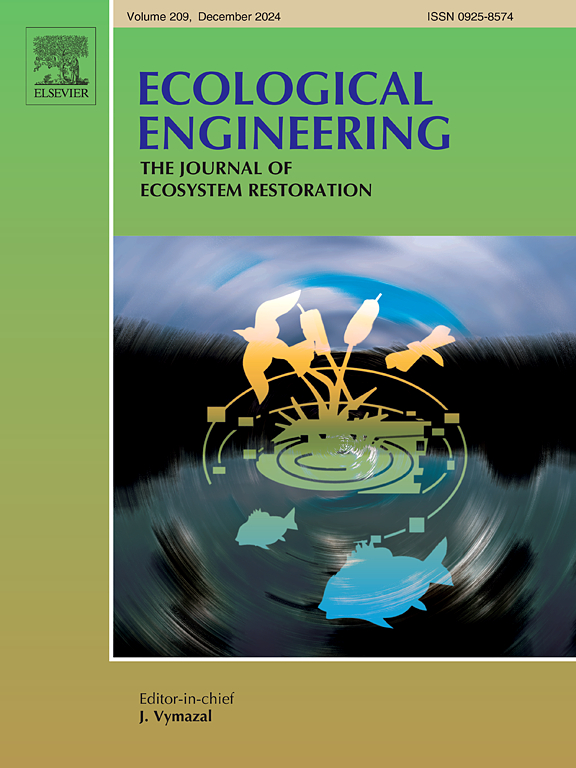景观配置对水体净化能力的影响——以高原湖滨湿地为例
IF 4.1
2区 环境科学与生态学
Q1 ECOLOGY
引用次数: 0
摘要
湖滨湿地景观配置在水体净化中起着关键作用,因此研究湖滨湿地生态修复如何重塑这些格局以改善水质是十分必要的。本研究通过分析高原湖滨湿地从入水口到出水口污染物浓度的地理变化,识别影响湿地净化能力的潜在关键景观因子,评价高原湖滨湿地恢复后的水质净化能力有效性。结果表明,修复后的湖滨湿地对水体中总氮、总磷和高锰酸盐的平均去除率分别为63.76%、71.10%和28.74%,显示出较强的养分去除和水体净化能力。冗余分析和变异分区分析表明,界面特性对净化能力的影响最大(28.1%),其次是土地利用结构参数和生境要素的协同效应(16.3%),其次是土地利用生境要素和结构参数的独立效应(13.2%)和结构参数的独立效应(12.2%)。其中,缓坡显著提高了氮潴留(p <;0.05)。具有复杂群落结构的植被界面区显著增强了营养物的去除,证明了在湖滨湿地战略性地建设草地-水和森林-水界面以最大限度地减少污染物。这些发现为通过有针对性的景观配置和管理优化湖边湿地恢复建立了可操作的框架,从而显著增强了湖泊生态系统的长期水质保护。本文章由计算机程序翻译,如有差异,请以英文原文为准。

Impact of landscape configuration on water purification capacity: A case study in a plateau lakeside wetland
The landscape configuration of lakeside wetlands plays a pivotal role in mediating water purification, making it essential to investigate how ecological restoration in the wetlands around lakeshore reshapes these patterns to improve water quality. In this study, the effectiveness of a restored plateau lakeside wetland in water purification capacity was evaluated by analyzing the geographical variation of contaminant concentrations from inlets to outlets and identifying potential key landscape factors affecting purification capacity. The results showed that the average removal efficiencies of total nitrogen, total phosphorus, and permanganate index were 63.76 %, 71.10 %, and 28.74 %, respectively, demonstrating the significant capability of the restored lakeside wetland in nutrient removal and water purification. Redundancy analysis and variation partitioning analysis indicated that interface properties had the greatest impact on purification capacity (28.1 %), followed by the synergistic effect of structural parameters and habitat elements for land use (16.3 %), and the independent effect of habitat elements for land use (13.2 %) and structural parameters (12.2 %). Among them, gentle slopes were found to significantly enhance nitrogen retention (p < 0.05). The vegetated interface areas with complex community structures significantly enhanced nutrient removal, justifying the strategic construction of grassland-water and forest-water interfaces in lakeside wetlands to maximize contaminant mitigation. These findings established actionable frameworks for optimizing lakeside wetland restoration through targeted landscape configuration and management, thereby significantly enhancing long-term water quality protection in lake ecosystems.
求助全文
通过发布文献求助,成功后即可免费获取论文全文。
去求助
来源期刊

Ecological Engineering
环境科学-工程:环境
CiteScore
8.00
自引率
5.30%
发文量
293
审稿时长
57 days
期刊介绍:
Ecological engineering has been defined as the design of ecosystems for the mutual benefit of humans and nature. The journal is meant for ecologists who, because of their research interests or occupation, are involved in designing, monitoring, or restoring ecosystems, and can serve as a bridge between ecologists and engineers.
Specific topics covered in the journal include: habitat reconstruction; ecotechnology; synthetic ecology; bioengineering; restoration ecology; ecology conservation; ecosystem rehabilitation; stream and river restoration; reclamation ecology; non-renewable resource conservation. Descriptions of specific applications of ecological engineering are acceptable only when situated within context of adding novelty to current research and emphasizing ecosystem restoration. We do not accept purely descriptive reports on ecosystem structures (such as vegetation surveys), purely physical assessment of materials that can be used for ecological restoration, small-model studies carried out in the laboratory or greenhouse with artificial (waste)water or crop studies, or case studies on conventional wastewater treatment and eutrophication that do not offer an ecosystem restoration approach within the paper.
 求助内容:
求助内容: 应助结果提醒方式:
应助结果提醒方式:


